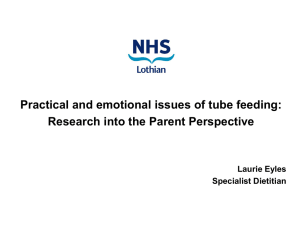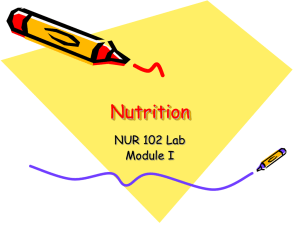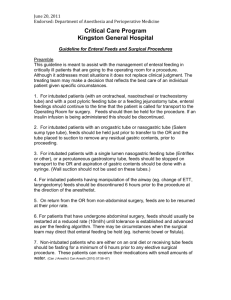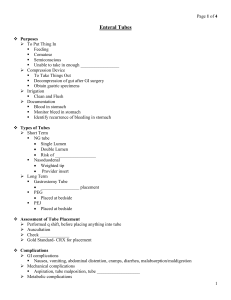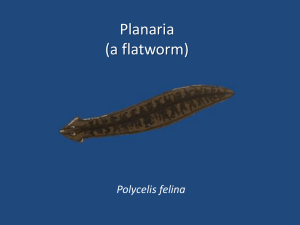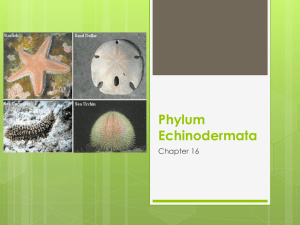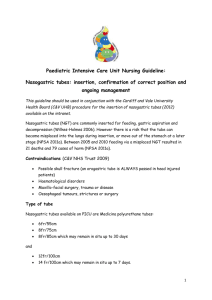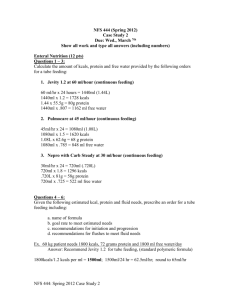NFS 444 (Spring 2012) - Dietetic Internship Portfolio
advertisement
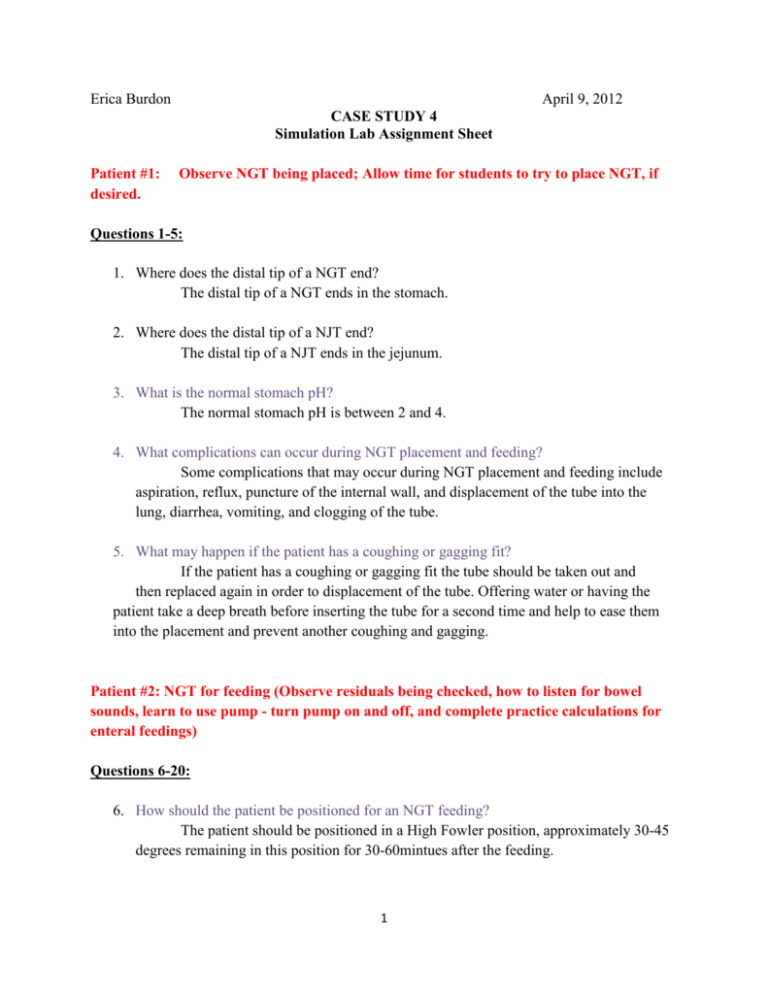
Erica Burdon April 9, 2012 CASE STUDY 4 Simulation Lab Assignment Sheet Patient #1: desired. Observe NGT being placed; Allow time for students to try to place NGT, if Questions 1-5: 1. Where does the distal tip of a NGT end? The distal tip of a NGT ends in the stomach. 2. Where does the distal tip of a NJT end? The distal tip of a NJT ends in the jejunum. 3. What is the normal stomach pH? The normal stomach pH is between 2 and 4. 4. What complications can occur during NGT placement and feeding? Some complications that may occur during NGT placement and feeding include aspiration, reflux, puncture of the internal wall, and displacement of the tube into the lung, diarrhea, vomiting, and clogging of the tube. 5. What may happen if the patient has a coughing or gagging fit? If the patient has a coughing or gagging fit the tube should be taken out and then replaced again in order to displacement of the tube. Offering water or having the patient take a deep breath before inserting the tube for a second time and help to ease them into the placement and prevent another coughing and gagging. Patient #2: NGT for feeding (Observe residuals being checked, how to listen for bowel sounds, learn to use pump - turn pump on and off, and complete practice calculations for enteral feedings) Questions 6-20: 6. How should the patient be positioned for an NGT feeding? The patient should be positioned in a High Fowler position, approximately 30-45 degrees remaining in this position for 30-60mintues after the feeding. 1 7. How much formula should be put in a feeding bag for a continuous feeding? A feeding bag for a continuous feeding should have no more than four hours worth of formula. If this was a closed system the bag may have 24-48 hours’ worth of formula. If there is left over formula in the bag when the four hours is up, dispose the rest. 8. What is the feeding rate at? According to the tag on the hanging bag, the feeding rate is at 60 ml/hr. Always remember to check the orders and back to see what the rate should be at. 9. What rate should a tube feeding be started at? Why? Many hospitals have different protocols for tube feeding rates. According to ASPEN guidelines and in order to prevent refeeding syndrome the rate should be between 20 and 30 ml/hr to start. The rate should be increased by 20 ml/hr every 4-8 hours as tolerated. 10. How often should residuals be checked? The residuals should be checked every 4 hours for the first 48 hours and then every 4-8 hours in order to make sure the patient is tolerating the tube feeding. 11. What do you do if residuals are >150 mL? How should you check residuals with bolus feeds? If the residuals are greater than 150 mL the feeding should be stopped and the physician should be informed. The residuals should be check before each bolus feeding to ensure efficient gastric emptying. 12. A.)Why should you flush the tube during a continuous feed? Flushing of the tube during a continuous feed is important to prevent clogging and maintain patency. It is also important to make sure the hydration needs are being met. B.) If the tube becomes clogged, what can be used to dissolve the clot? When the tube becomes clogged, you can use pancreatic enzymes to breakdown the clot. Some more commonly seen ways to dissolve a clot are by using sterile water, soda, and cranberry and orange juice. 13. A.)What are the guidelines for flushing the tube when given medications? The tube should be flushed with 15ml of water before and after medication is administered. B.)Which medications should not be given through a feeding tube? 2 Medications that contain an enteric coating and are syrup based medications should not be given through feeding tubes. Also, it is important to never crush up the medication and put it directly into the tube since the patient will receive all the medication at once. 14. How often is the feeding bag and tubing changed? The feeding bad is changed every 4-8hours and the tubing is changed every 24 hours. The ready-to-hang should be changed after 24-48 hours. 15. What information would you find on an I&O sheet? The information found on an I&O sheet includes the input and output of each patient receiving NPO. The input includes all fluids such as IV, water and medications. The output information includes fluid loss through urine and vomit. The time, amount and rate of feeding and how much the patient actually received is also found on the I&O sheet. What goes is must come out of the patient so it must be marked appropriately. 16. What would you recommend if the patient did not have bowel sounds? If a patient did not have bowel sounds I would recommend further assessment of the stomach to listen for delayed sounds. If there is still no bowel sounds, it is recommended to stop the tube feeding and call the physician. Make sure to check fluid and electrolyte intake. It is also important to make sure there are no obstruction or tube displacements. 17. Which formula is most appropriate for a renal patient? A patient with diabetes? A patient with respiratory failure? The most appropriate formula for a renal patient is Nepro. For a patient with diabetes I would recommend using Glucerna. For a patient with respiratory failure I would use pulmocare. 18. Name two common standard enteral formulas. The two most common standard enteral formulas are Jevity and Osmolite. 19. How many kcals, protein and free water is provided when Jevity is running at 80ml/hr? Jevity 1.2 80ml/hr x 24hr = 1920ml (1.92L) 1920ml x 1.2kcals/ml = 2304 kcals 1.92L x 55.5g/L = 106.56g Protein 1920ml x .807 = 1549ml Free water 3 Jevity 1.5 80ml/hr x 24hr = 1920ml (1.92L) 1920ml x 1.5kcals/ml = 2880 Kcals 1.92L x 63.8g/L = 122.5g Protein 1920ml x .760 = 1459ml Free water 20. How many kcals, protein, and free water is provided when Nepro with Carb Steady is running at 50ml/hr? Nepro with Carb Steady 50ml/hr x 24hr = 1200ml (1.2L) 1200ml x 1.8kcals/ml = 2160 Kcals 1.2L x 81g/L = 97.2g Protein 1200ml x .725 = 870ml Free water Patient #3: TPN – Observe two manikins: one with a PICC line, one with a central line place in subclavian vein. Questions 21-28: 21. When is it an indication to use TPN over enteral feeding? It is an indication to use TPN over enteral feeding when a patient is unable to swallow, is at risk for aspirating, may have rectal bleeding, or is on bowel rest. 22. What are some of the complications that can occur when using TPN? Complications that may occur when using TPN are infection, clogging, refeeding syndrome, and phlebitis/embolism. Some others are imbalanced electrolytes and complications since the GI tract is not being used. 23. What is a PICC line? A PICC line is a peripheral inserted central catheter that is inserted through the arm and reaches the superior vena cava of the heart. 24. Which of the two manikins has a PICC line? Which has the central line through the subclavian vein? Manikin named Harry #2 (left) had the PICC line and manikin Harry #1 (right) had the central line through the subclavian vein. 4 25. Which manikin has the 2-in-1 TPN? Which one has the 3-in-1? How can you tell? What are some advantages and disadvantages of each? Harry #1 (right) has the 2-in-1 TPN and twin Harry #2 (left) has the 3-in-1 TPN. I was able to tell which manikin had a 2-in-1 and a 3-in-1 since for manikin #1 there was a separate bag hanging containing the lipids. I also noticed the difference since the 3-in-1 had a milky appears. Some advantages to the 3-in1 are that it takes less time for the nursing staff to maintain the separate lipid solution. This type of TPN has less risk of contamination, requires less pharmacy preparation time, and is less expensive to administer. The disadvantage of this PN formulation is that it decreases stability and compatibility for the patient as well as impairs the visual inspection of the nutrients being provided. Some advantage to using a 2-in-one solution is that you are able to see what nutrients are being provided and it does not decrease the stability of the formula. On the other hand using a 2-in-1 solution can be a concern since the lipids that contain a lot of linoleic acid can suppress the immune response. 26. How many kcals and protein does the following order provide: 1.5L with 30% dextrose, 5% a.a., and 2% lipid? 300g x 1.5L = 450g x 3.4kcals/g = 1530 kcals Dextrose 50g x 1.5L = 75g x 4kcals/g = 300 kcals Amino Acid 20g x 1.5L = 20g x 10kcals/g = 200 kcals Lipid Total: 1530 dex + 300 aa + 200 lipids = 2030 kcals 27. What is the osmolarity of the solution (from #26) if the total of the ‘lytes is 180? Can it be given through a PICC line? Explain. 300g x 5mOsm/g = 1500 mOsm x 1.5L = 2230 mOsm Dextrose 50g x 10mOsm/g = 500 mOsm x 1.5L = 750 mOsm Amino Acid 20g x 1.5mOsm/g = 30 mOsm x 1.5L = 45 mOsm Lipid 180mmol x 2mOsm/g = 360 mOsm x1.5L = 540 mOsm Electrolytes Total: 3585 mOsm 5 Yes, the solution can be given through a PICC line since the line ends in the Superior Vena Cava and there is no specific limit for osmolarity. If putting the solution into a peripheral line the osmolarity should not exceed 900 mOsm. 28. How many kcals and protein from: 2L 25% dextrose and 3.5% a.a. with 250ml of 20% lipid running? 250g x 2L = 500g x 3.4kcals/g = 1700kcals 35g x 2L = 70g x 4kcals/g = 280kcals 250ml x 2.0kcals/ml = 500kcals Total: 2480 kcals Patient #4: Observe an infant with G-tube and an infant with a button. Also, two child manikins, one will have a NGT to suction. The second manikin will be fed enterally, and another pump will be used for students to practice adjusting rate, turn on and off. Questions 29 - 35 : 29. What acid base disorder would be common for someone who is on NGT suction? For someone who is on a NGT suction the most common disorder I metabolic alkalosis. 30. What fluid disorder may occur in a patient on NGT suction? The fluid disorders that may occur in a patient on NGT suction are Hypovolemia and dehydration. 31. What electrolytes may be lost due to NGT suction? Electrolytes that may be lost due to NGT suction are sodium and potassium. 32. What signs and symptoms may be seen in the patient with the above a. Acid-base disorder Metabolic alkalosis b. Fluid disorder Hyper or Hypovolemia c. Lost electrolytes Can lead to weakness or arrhythmia of the heart, unconsciousness and even death. 6 33. Describe the care of a gastrostomy button. The care of the gastrostomy button (Mikki) includes skin care and flushing the tube after administering the formula to maintain a clean area. 34. What is the advantage of using a button? The advantage of using a button is it makes it more convenient for the patient who may be using enteral nutrition long term. The patient is able to cover the button and have a normal life. Having a button can also decrease the risk of infection that would be commonly found in a normal tube feeding. 35. What information will you find on an I & O sheet of a patient with NGT to suction? The information found on an I&O sheet of a patient with NGT to suction is the amount of liquid going out and the medication given to the patient. 7
